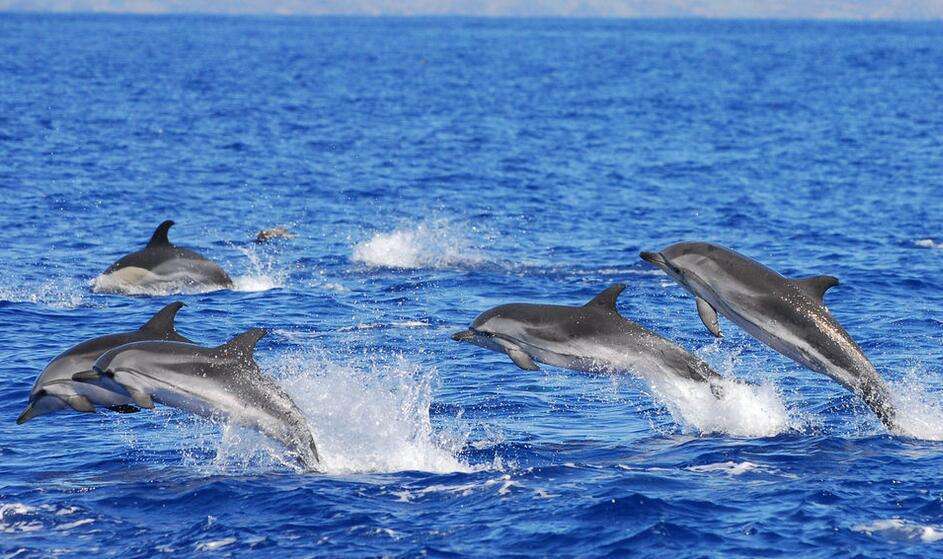Stenella coeruleoalba
IUCN
LCBasic Information
Scientific classification
- name:Stenella coeruleoalba
- Scientific Name:Stenella coeruleoalba,Striped dolphin,Blue and white dolphin, blue and white dolphin, striped dolphin
- Outline:Cetacea
- Family:Odontoceti Delphinidae Prodolphinidae
Vital signs
- length:2.2-2.4m
- Weight:150-160kg
- lifetime:About 55 years
Feature
A dolphin with spray-marked hair that excels at mid-air tail turns
Distribution and Habitat
Widely distributed in tropical and temperate waters of the Atlantic, Pacific and Indian Oceans, and also in the Mediterranean Sea adjacent to the Atlantic Ocean. In China, it is only found along the coast near Suao, Taiwan. The approximate distribution range is between 40° south latitude and 50° north latitude.
Origin (sea area): American Samoa, Angola, Antigua and Barbuda, Aruba Island, Australia, Bahamas, Bangladesh, Barbados, Belize, Benin, Belgium, Brazil, Canada, Cape Verde, Chile, China, Colombia, Costa Rica, Côte d'Ivoire, Croatia, Cuba, Cyprus, Denmark, Ecuador, Faroe Islands, France, Gibraltar, Greece, Greenland, Honduras, India, Indonesia, Ireland, Israel, Italy, Jamaica, Japan, Maldives, Malta, Mauritania, Mexico, Monaco, Montenegro, Morocco, Mozambique, Netherlands, Netherlands Antilles, New Zealand, Norway, Oman, Panama, Peru, Philippines, Portugal, Russia, Saint Vincent and the Greennadines, Senegal, Seychelles, Solomon Islands, Somalia, South Africa, Spain, Sri L
Appearance
The average maximum body length of males is 2.4 meters, and that of females is 2.2 meters. The body is slightly thick, and the beak is medium-long. The dorsal fin is sickle-shaped. The body is spotted with blue and white, and there is a dark blue to blue-black stripe from the eye to the anus and from the eye to the flipper. A secondary stripe often separates from the front of the eye-to-anus stripe and extends to the ventral side. The dorsal cape is blue or blue-gray, with a white to light gray ridge extending from the flank into the cape to the bottom of the dorsal fin. The sides of the body are light gray, and the ventral side is white to pink. The flippers and dorsal fin are dark gray to black.
The snout of the skull is flattened dorsally and ventrally, the palatine groove is very shallow, the preorbital process is relatively long, and the temporal fossa is small. The mandibular symphysis is short. Each tooth row has 39 to 55 small and sharp teeth.
The typical vertebral form i
Details
Striped dolphin, with no subspecies, is a common dolphin in the Pacific Ocean.

Striped dolphin has the habit of living in the ocean. They often move in groups of dozens to hundreds, and there are also large groups of thousands of them; in the Western Pacific, the groups can be divided into: juvenile groups, breeding adult groups, and non-breeding adult groups. Juvenile dolphins usually join the juvenile group 1 to 2 years after weaning. When females enter the transition stage from juvenile to adult, they generally join the non-breeding adult group, and only a few sneak into the breeding adult group, while the proportion of males joining the breeding adult group and the non-breeding adult group during the same period is similar.
Striped dolphins are very active by nature, often performing aerial movements such as leaping, jaw slamming, bow riding (riding the pressure waves of ships or whales, twisting and jumping from time to time), and a unique set of "spinning tail flicks" (jumping high and quickly spinning the tail blade before falling into the water).
Striped dolphins mainly feed on pelagic and benthic cephalopods, crustaceans and bony fish. There are some differences in diet in different regions. In the waters of Japan and South Africa, they mainly feed on Myctophidae fish, in the northeastern Atlantic, they mainly feed on cod, and in the Mediterranean, they feed more on squid. Observations of the feeding areas of striped dolphins show that they mainly forage in the deep sea along the continental slope or in the oceanic benthic areas (they can dive to a depth of 200 to 700 meters).
The maturity period of striped dolphins varies greatly, with males reaching sexual maturity at 7 to 15 years old and females at 5 to 13 years old. The mating period of striped dolphins in the northwest Pacific is in winter and early summer, and in the Mediterranean in autumn. The gestation period lasts 12 to 13 months, and females usually give birth once every four years, followed by a 2 to 6 month interval between nursing the young and the next mating season. The average length of newborn young is 93 to 100 cm, weighing about 11.3 kg, growing about 0.29 cm per day, and the nursing period is 16 months.
Listed in the "China Species Red List": Vulnerable (VU).
Listed in Appendix II of the Convention on the Conservation of Migratory Species of Wild Animals (CMS).
Listed in Appendix II of the Convention on International Trade in Endangered Species of Wild Fauna and Flora (CITES).
Listed in the "National Key Protected Wildlife List": National Class II Protected Animal (effective December 10, 1988, all species of the Delphinidae family)
Listed in the "IUCN Red List of Endangered Species": Least Concern (LC), assessed in 2008.
Listed in the "China National Key Protected Wildlife List" Class II.
Protect wildlife and eliminate game.
Maintaining ecological balance is everyone's responsibility!








